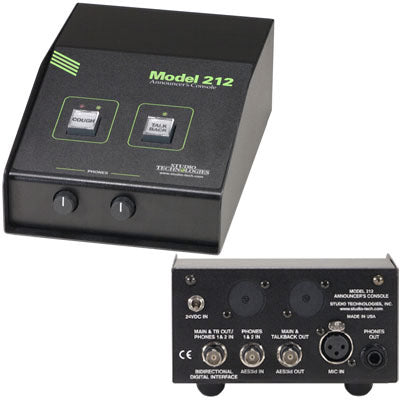
Description
Studio Technologies Studiocomm Model 212 Digital Announcer's Console
The Model 212 Announcer's Console is an audio control "hub" for announcers, commentators, and production personnel that features digital audio input and output resources. The broadcast-standard interfaces allow direct integration of the table-top unit into contemporary "all-digital" environments.Key FeaturesMicrophone preamp with selectable gain and 48 volt phantom power
Two digital audio input channels
Two pushbutton switches offer programmable "click-free" audio path control
Digital audio main and talkback output channels
Digital interfaces directly compatible with unbalanced AES digital audio signals
Bidirectional digital interface for direct integration with Riedel intercom systems
Stereo headphone monitoring of selectable sources
Two rotary headphone output level controls
Microcontroller-directed audio routing
All configuration switches accessible via the bottom of the enclosure
Flexible Setup
Two pushbutton switches""Main and Talkback""operate under microprocessor control to offer unmatched flexibility and "click-free" audio routing. The Main button controls the main output audio channel with operating modes that include push-to-mute (cough), push-to-talk, and latching. The Talkback button controls an audio channel that provides talent-oriented cue signals to production personnel. Both channels are formatted into an AES digital audio "stream" that is routed to two BNC interfaces: an AES3id-compliant output and a bidirectional digital interface for direct integration with Riedel intercom systems. For non-on-air applications a special feature set referred to as "production" mode can be enabled. Simple customization of the button labels ensures the user is presented with an easy-to-use set of controls and indicators.
Superior Audio
Featuring a studio-inspired low-noise/low-distortion preamplifier design, adjustable gain, and 48 volt phantom power, the Model 212 is compatible with balanced dynamic and condenser microphones. A sophisticated compressor circuit controls the dynamic range of the audio signal from the microphone preamplifier to ensure the main output offers faultless performance as the on-air or other primary audio feed.
Powerful Monitoring
The headphone output's circuitry provides high output levels with very low distortion and noise. The user can monitor audio channels from among the three digital audio sources: the AES3id input, the bidirectional digital interface, and an optionally implemented AES3 input. Each source can be individually assigned to the left, right, or both channels of the binaural headphone output. Two rotary controls allow the user to adjust the headphone output levels.
Speedy Configuration
Model 212 configurations are made using DIP-type switches that are accessible via the bottom of the enclosure. No disassembly is required. An included security panel attaches to the bottom of the enclosure to limit access.
Installer Friendly
The Model 212 is powered by the supplied external 24 volt DC source. Audio inputs and outputs utilize industry-standard connections""XLR for the microphone and 75 ohm BNC for the digital inputs and outputs. Two spare connector locations are available on the Model 212's back panel. Factory-available assemblies and card kits allow a technician to customize these spare locations to accept a 6- or 7-pin XLR-type headset or to bring remote switch inputs to an XLR connector. Additional card kits include balanced 110 ohm (AES3) digital input or output connections, direct microphone output, and line-level input. The optional rack-mounted Model 44 Interface can provide power and signal routing over Ethernet-style interface cables to up to six Model 212 units (EtherCon Connector Card Kit required).
| General Audio | |||||||||||||||||||||||||
| Frequency Response | < Ð0.1 dB at 20 Hz, Ð1 dB at 18 kHz, mic in/main out | ||||||||||||||||||||||||
| Distortion (THD+N) | 0.025%, measured at 1 kHz, mic in/main out | ||||||||||||||||||||||||
| S/N Ratio | 71 dB, referenced to Ð46 dBu mic in/ Ð14 dBFS out | ||||||||||||||||||||||||
| Common Mode Rejection Ratio | 68 dB at 60 Hz | ||||||||||||||||||||||||
| Connectors | |||||||||||||||||||||||||
| Mic In | 3-pin female XLR-type | ||||||||||||||||||||||||
| AES3id Out, AES3id In, Bidirectional Interface: | 75 ohm BNC | ||||||||||||||||||||||||
| Headphone Out | _-inch 3-conductor phone jack | ||||||||||||||||||||||||
| 24 Vdc Power In | 2.1 x 5.5 mm coaxial power jack | ||||||||||||||||||||||||
| Spare Connector Locations | 2, Allows one or two Neutrik NC*D-L-1 connectors to be installed (*=3F, 3M, 5F, 5M, 6F, 6FS, etc.) | ||||||||||||||||||||||||
| Digital Inputs/Outputs | |||||||||||||||||||||||||
|
Studio Technologies Studiocomm Model 212 Digital Announcer's Console The Model 212 Announcer's Console is an audio control "hub" for announcers, commentators, and production personnel that features digital audio input and output resources. The broadcast-standard interfaces allow direct integration of the table-top unit into contemporary "all-digital" environments.Key FeaturesMicrophone preamp with selectable gain and 48 volt phantom power Flexible Setup Two pushbutton switches""Main and Talkback""operate under microprocessor control to offer unmatched flexibility and "click-free" audio routing. The Main button controls the main output audio channel with operating modes that include push-to-mute (cough), push-to-talk, and latching. The Talkback button controls an audio channel that provides talent-oriented cue signals to production personnel. Both channels are formatted into an AES digital audio "stream" that is routed to two BNC interfaces: an AES3id-compliant output and a bidirectional digital interface for direct integration with Riedel intercom systems. For non-on-air applications a special feature set referred to as "production" mode can be enabled. Simple customization of the button labels ensures the user is presented with an easy-to-use set of controls and indicators. Superior Audio Featuring a studio-inspired low-noise/low-distortion preamplifier design, adjustable gain, and 48 volt phantom power, the Model 212 is compatible with balanced dynamic and condenser microphones. A sophisticated compressor circuit controls the dynamic range of the audio signal from the microphone preamplifier to ensure the main output offers faultless performance as the on-air or other primary audio feed. Powerful Monitoring The headphone output's circuitry provides high output levels with very low distortion and noise. The user can monitor audio channels from among the three digital audio sources: the AES3id input, the bidirectional digital interface, and an optionally implemented AES3 input. Each source can be individually assigned to the left, right, or both channels of the binaural headphone output. Two rotary controls allow the user to adjust the headphone output levels. Speedy Configuration Model 212 configurations are made using DIP-type switches that are accessible via the bottom of the enclosure. No disassembly is required. An included security panel attaches to the bottom of the enclosure to limit access. Installer Friendly The Model 212 is powered by the supplied external 24 volt DC source. Audio inputs and outputs utilize industry-standard connections""XLR for the microphone and 75 ohm BNC for the digital inputs and outputs. Two spare connector locations are available on the Model 212's back panel. Factory-available assemblies and card kits allow a technician to customize these spare locations to accept a 6- or 7-pin XLR-type headset or to bring remote switch inputs to an XLR connector. Additional card kits include balanced 110 ohm (AES3) digital input or output connections, direct microphone output, and line-level input. The optional rack-mounted Model 44 Interface can provide power and signal routing over Ethernet-style interface cables to up to six Model 212 units (EtherCon Connector Card Kit required).
| |||||||||||||||||||||||||

